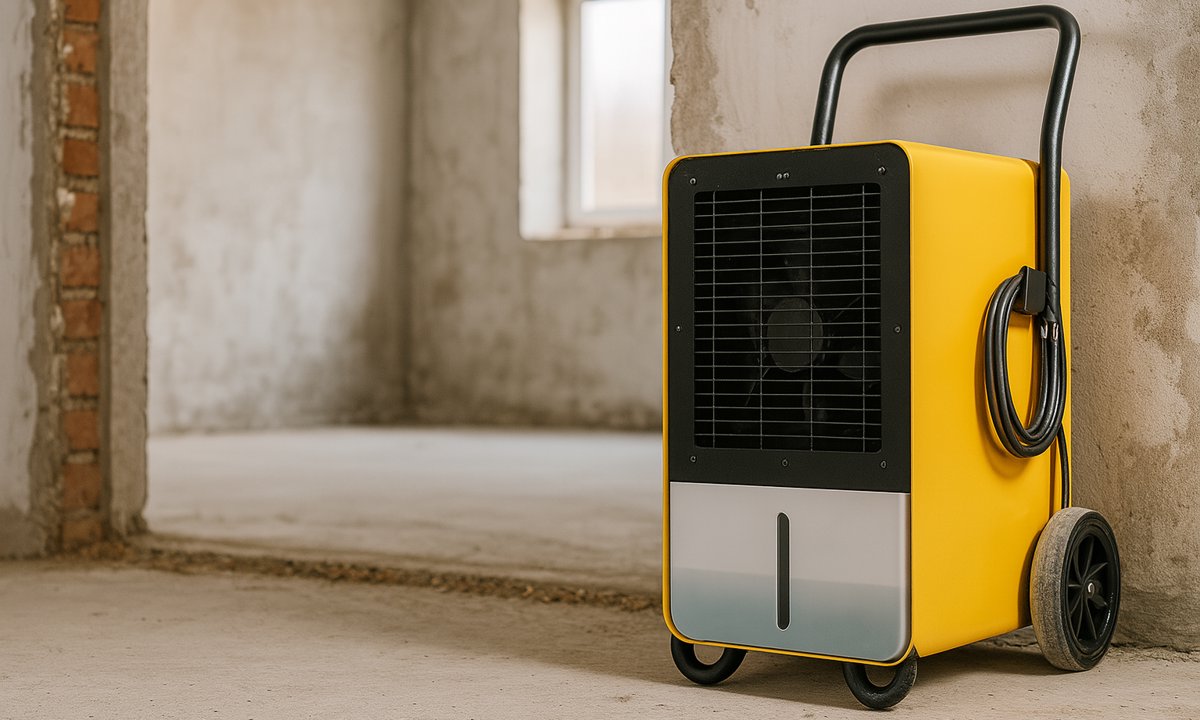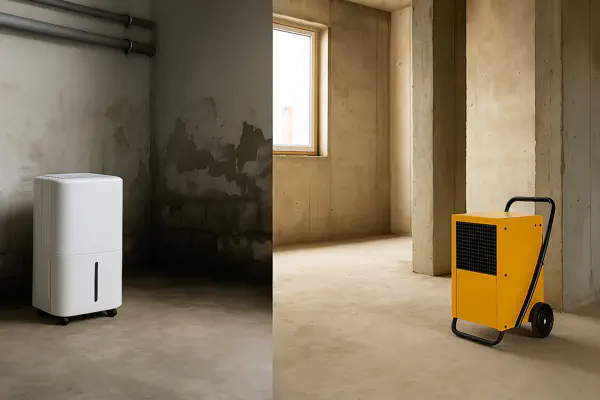
When Should You Use a Building Dryer?
A building dryer is used wherever not only the air humidity needs to be reduced, but also the floor or masonry needs to be dried. It is indispensable for new buildings, after water damage, or for screed drying. It actively accelerates the drying process and ensures that no residual moisture remains, which is crucial for subsequent construction work or in case of mold risk.
A standard dehumidifier can remove light moisture from the air but cannot deeply dry soaked walls, ceilings, or floors. That’s exactly what a building dryer is for: high performance, fast effect, often used in continuous operation.
Building Dryers in Detail: Function, Types, and Differences
How does a building dryer work? The principle is simple: it draws in moist air, removes the moisture by condensation or adsorption, and blows the dried air back into the room. This accelerates evaporation in the affected materials.
Types:
- Condensation Dryers: Standard for new construction and renovation, efficient at higher temperatures.
- Adsorption Dryers: For colder environments or special cases, e.g., winter construction sites.
Typical Areas of Use:
- New construction (e.g., screed drying)
- Renovation (e.g., mold removal)
- Water damage (e.g., after pipe burst)
- Renovation (e.g., after painting)
Our Top Recommendation below
Overview: Building Dryer vs. Dehumidifier
| Situation | Recommendation | Reason |
|---|---|---|
| Humid air in apartment | Dehumidifier | Energy-saving, sufficient for light moisture |
| Water damage in basement | Building Dryer | Deep effect necessary |
| Mold after pipe burst | Building Dryer | Intensive, fast drying to prevent mold |
| Screed drying in new build | Building Dryer | Shortens waiting time for ready-to-cover floors |
| Mold in bedroom | Dehumidifier | For stabilization after drying |
| Winter construction site | Adsorption Dryer | Works even at low temperatures |
Buying a Building Dryer: New vs. Used Devices
Buying a New Building Dryer - Prices and Recommendations
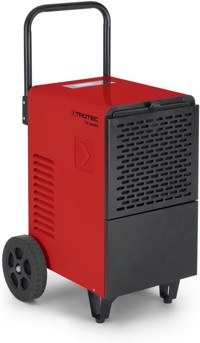
- Up to 52 L/24 h (300 m³/h) – ideal for commercial use & construction sites
- Large digital display: shows RH & temperature; hygrostat 10–95% in 1% steps
- Robust and mobile: carry handle, large wheels; 7 L tank, timer, auto-defrost, external drain
Bauhaus Building Dryer:
- Atika ALE 600*: approx. €350-400 (30L/day)
- Güde GBT 50.1*: approx. €280-320 (50L/day)
- Trotec TTK 170 ECO*: approx. €450-500 (52L/day)
Hornbach Building Dryer:
- Remko ETF 360*: approx. €380-420 (36L/day)
- Wilms KT 52: approx. €320-380 (52L/day)
- Focus on energy-efficient models
OBI Building Dryer:
- Atika ALE 800*: approx. €400-450 (40L/day)
- Güde models often on offer
- Regular promotional prices
Buying a Used Building Dryer - What to Look For?
eBay Classifieds Building Dryer:
- Price range: €150-350 depending on condition
- Look for: operating hours, maintenance history
- Risk: no warranty, possible repair costs
Used Building Dryers from Professionals:
- Ex-rental devices often in good condition
- Price: €200-400 with warranty
- Advantage: usually well maintained and functional
Buying Advice: Rent or Buy a Building Dryer?
When buying is worthwhile:
- For regular use (more than 4 weeks/year)
- For craftsmen and renovators
- For larger renovation projects
- If local rental prices are high
Purchase criteria:
- Performance: At least 30 liters/day for living spaces
- Energy efficiency: A+ class saves electricity costs
- Functions: Hygrostat and timer are essential
- Brand quality: Trotec, Atika, Remko are proven
Practical Application: Setting Up and Operating a Building Dryer Correctly
Setting Up a Building Dryer - How To
Setup after water damage:
- At least 50cm distance from walls for air circulation
- Keep windows and doors closed during operation
- For multiple rooms: open doors for better air distribution
- Place the building dryer centrally in the affected area
Screed drying with a building dryer:
- Use only 3-5 days after pouring
- Continuous operation for 2-4 weeks depending on screed thickness
- Keep room temperature at 18-22°C for optimal drying
- Do not lower humidity below 40% (risk of cracks)
Setting up a building dryer in the basement:
- Use a drain hose for wastewater (less emptying)
- At low temperatures: run heating in parallel
- Watch power consumption: 500-800W continuously
Power Consumption and Operating Costs
Building dryer power consumption per day:
- Small devices (20L): approx. 400-600W = €2.40-3.60 daily
- Mid-range (40L): approx. 600-800W = €3.60-4.80 daily
- Professional devices (60L+): approx. 800-1200W = €4.80-7.20 daily
- Basis: €0.30/kWh electricity price
Minimizing daily power costs:
- Use timer function (do not run 24h)
- Set hygrostat optimally (usually 50-60% rel. humidity)
- For screed: run only during the day (pause at night)
- Choose energy-efficient models (A+ energy class)
Common Problems and Solutions
Building dryer does not collect water in the tank:
- Humidity already too low (below 50%)
- Hygrostat set incorrectly
- Condenser dirty or defective
- Solution: check settings, call service if necessary
Building dryer noise - avoiding disturbance:
- Modern devices: 45-55 dB (comparable to a refrigerator)
- For neighbors: restrict operation to 7am-10pm
- Place soundproof mats under the device
- In living spaces: turn off device at night
Windows open or closed when using a building dryer?
- Rule: Windows CLOSED during operation
- Exception: brief airing once a day (5-10 min)
- For screed in summer: air at night, closed during the day
- Reason: humid outside air reduces efficiency
Tax Deductibility and Insurance
Building dryer tax deductible:
- For rentals: fully as advertising costs
- For owner-occupiers after water damage: often as extraordinary burden
- Commercial: as business expense
- Tip: keep receipts for rental and electricity costs
Rent reduction when using a building dryer:
- For water damage caused by third parties: 10-30% rent reduction possible
- Noise and electricity costs can be claimed
- Important: document building dryer use (photos, receipts)
Renting a Building Dryer: Costs and Providers Compared
DIY Store Comparison: Where to Rent Cheapest?
Bauhaus Building Dryer Rental:
- Price: €8-15/day depending on model
- Available brands: Trotec, Atika, Heylo
- Advantages: wide selection, often weekly discounts
- Deposit: usually €50-100
Hornbach Building Dryer Rental:
- Price: €7-12/day for standard devices
- Popular models: Trotec TTK 170 ECO, Remko ETF
- Advantages: online reservation possible
- Service: expert advice on site
OBI Building Dryer Rental:
- Price: €6-14/day depending on performance
- Focus: Atika and Güde building dryers
- Advantages: often the cheapest daily rates
- Additional service: delivery for larger projects
Toom Building Dryer Rental:
- Price: €8-13/day
- Equipment: usually with hose and timer
- Advantages: flexible rental periods
- Tip: weekend rates often cheaper
Hagebaumarkt Building Dryer Rental:
- Price: €9-16/day
- Focus: professional devices for craftsmen
- Advantages: longer rental periods with discounts
- Service: instruction upon pickup
Specialized Providers: Boels and Professional Companies
Boels Building Dryer Rental:
- Price: €15-25/day for professional devices
- Focus: high-performance building dryers
- Advantages: 24/7 service, nationwide availability
- Target group: professional restoration companies
Local building dryer companies nearby:
- Usually €10-20/day plus travel
- Advantages: personal advice, emergency service
- Service: often with setup and instruction
- Tip: faster availability in case of water damage
Our Buying Tip: Comedes BTR 50*
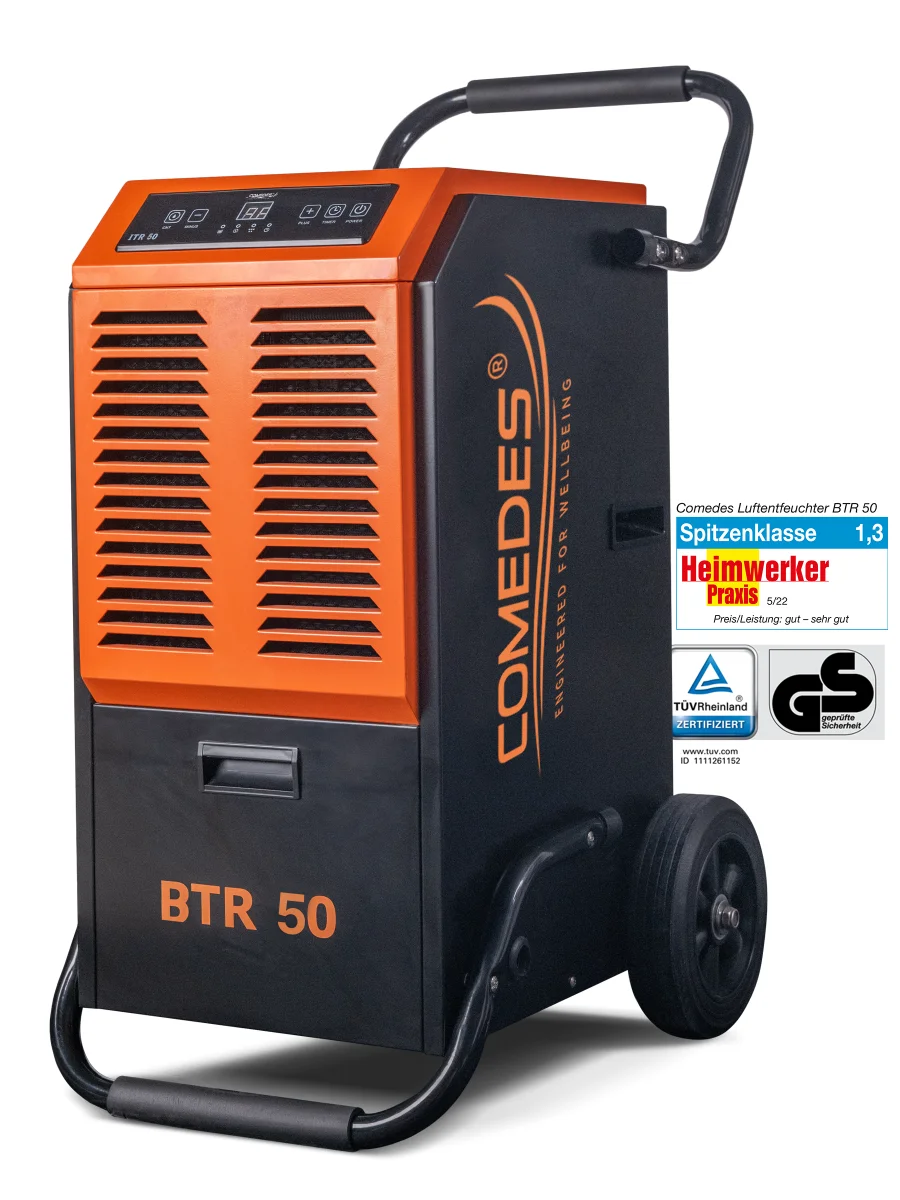
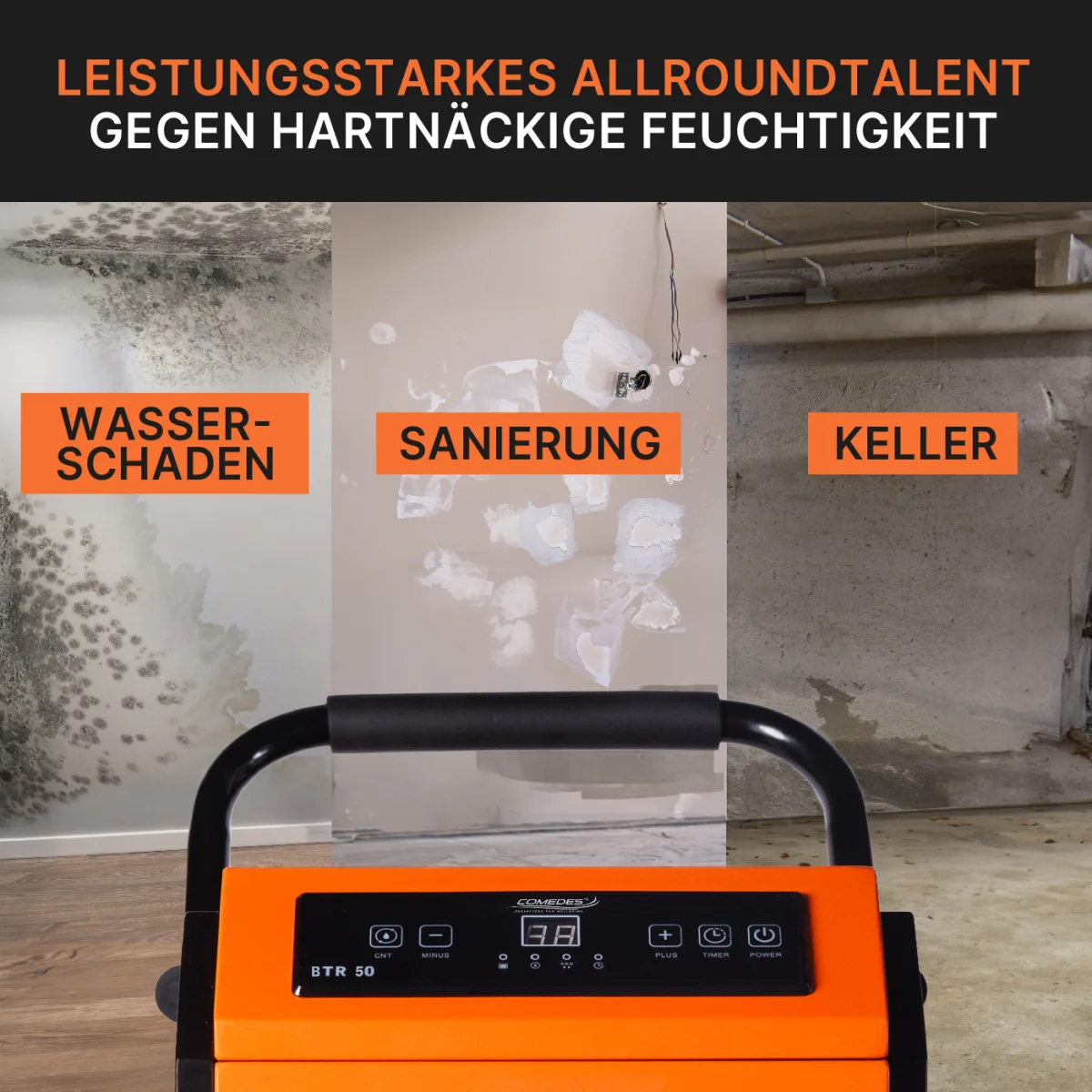
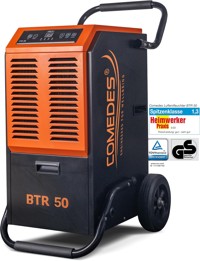
- Performance: up to 51 L/day – dehumidifies up to 50 m², keeps up to 100 m² dry (≈230 m³)
- Robust: metal housing, 5.5 L tank, easy-to-clean dust filter; automatic/continuous operation with auto-defrost
- Mobile: large wheels, padded handle & recessed grips – ideal for water damage, basements & construction sites
The Comedes Building Dryer BTR 50* (max. 51 liters / 24h) is a popular model with high performance and good energy efficiency. It is suitable for large rooms, basements, and is ideal for new buildings or renovations. The price-performance ratio is excellent, and it is easy to use.
The Comedes BTR 50 offers the following features:
- High dehumidification performance: Up to 51 liters per day, ideal for large rooms and basements.
- Adjustable hygrostat: Automatic regulation of the desired humidity.
- Timer function: Flexible control of operating times.
- Continuous operation possible: For use with severe moisture problems.
- Automatic defrost: Efficient even at low temperatures.
- Transport wheels: Easy to move on the construction site or in the basement.
- Large water tank: Less frequent emptying, optional with hose connection for continuous operation.
This equipment makes the BTR 50 a reliable choice for new buildings, renovations, and quick drying after water damage.
Conclusion
A building dryer is the right device when it comes to fast and effective drying of construction sites, after water damage, or in case of mold. It provides the necessary power to penetrate deep into materials and remove residual moisture. For light moisture problems in living spaces, a dehumidifier is sufficient.
FAQ
Where can I rent a building dryer most cheaply?
OBI often has the lowest daily rates (€6-14), Bauhaus offers the best selection. Boels is more expensive but suitable for professional applications.How does a building dryer work exactly?
It removes moisture from the air by condensation or adsorption and thus supports the drying of materials.When should I rent a building dryer instead of buying?
For one-time use (water damage, new build). Buying is worthwhile from about 4 weeks of use or regular use.How much does it cost to rent a building dryer?
Depending on the provider €6-25/day. DIY stores are cheaper (€6-16), professional companies are more expensive (€15-25) but with more service.How long does a building dryer run for screed drying?
2-4 weeks continuously, depending on screed thickness and room temperature. Start from the 3rd-5th day after pouring.Windows open or closed when using a building dryer?
Basically CLOSED. Only brief airing once a day. Open windows drastically reduce efficiency.What are the daily electricity costs for a building dryer?
Depending on device size €2.40-7.20 daily at €0.30/kWh. Timer and hygrostat help save.Which building dryer brands are recommended?
Trotec TTK 170 ECO* (very efficient), Atika ALE 800* (good value), Remko ETF* (robust), Wilms (professional sector).Can you buy used building dryers?
Yes, on eBay Classifieds €150-350. Ex-rental devices from professionals are usually better maintained (€200-400).Turn off building dryer at night or let it run continuously?
For screed: can pause at night. For water damage: run continuously for faster drying. In living spaces, turn off at night (noise).How do I set up the building dryer correctly?
50cm distance from walls, centrally in the room, windows closed. For water damage: open doors to other rooms.What is normal: how much water does a building dryer collect?
Depending on room humidity 5-40 liters daily. More at the beginning of new water damage, then decreasing.Building dryer in living spaces - what to consider?
Noise (off at night), humidity not below 40%, power consumption, regular emptying of the tank.Is a building dryer tax deductible?
For rentals yes (advertising costs), for water damage often as extraordinary burden, commercially as business expense.Repairing a building dryer - is it worth it?
For devices over €300 new value, often yes. Common problems: condenser, hygrostat, fan. Repair €80-150.
More information on special dehumidifier applications can be found in our main guide.
